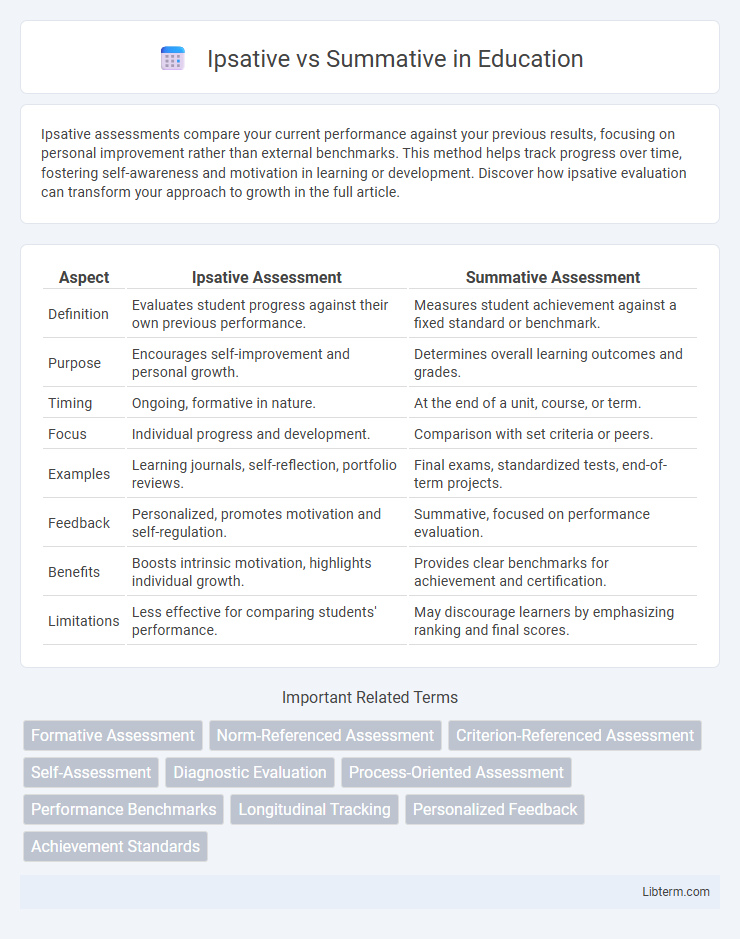Ipsative assessments compare your current performance against your previous results, focusing on personal improvement rather than external benchmarks. This method helps track progress over time, fostering self-awareness and motivation in learning or development. Discover how ipsative evaluation can transform your approach to growth in the full article.
Table of Comparison
| Aspect | Ipsative Assessment | Summative Assessment |
|---|---|---|
| Definition | Evaluates student progress against their own previous performance. | Measures student achievement against a fixed standard or benchmark. |
| Purpose | Encourages self-improvement and personal growth. | Determines overall learning outcomes and grades. |
| Timing | Ongoing, formative in nature. | At the end of a unit, course, or term. |
| Focus | Individual progress and development. | Comparison with set criteria or peers. |
| Examples | Learning journals, self-reflection, portfolio reviews. | Final exams, standardized tests, end-of-term projects. |
| Feedback | Personalized, promotes motivation and self-regulation. | Summative, focused on performance evaluation. |
| Benefits | Boosts intrinsic motivation, highlights individual growth. | Provides clear benchmarks for achievement and certification. |
| Limitations | Less effective for comparing students' performance. | May discourage learners by emphasizing ranking and final scores. |
Introduction to Ipsative and Summative Assessment
Ipsative assessment measures a learner's progress by comparing their current performance against their previous achievements, emphasizing personal growth and self-improvement. Summative assessment evaluates a learner's performance against a predetermined standard or benchmark, providing a final judgment on their knowledge or skills at the end of an instructional period. Ipsative assessment is often formative and ongoing, while summative assessment is typically conclusive and occurs after instruction.
Defining Ipsative Assessment
Ipsative assessment measures a learner's progress by comparing their current performance to their previous results, emphasizing personal growth and self-improvement. This type of assessment focuses on individual development rather than external benchmarks or norms. In contrast, summative assessment evaluates student achievement against predefined standards or criteria at the end of an instructional period.
Understanding Summative Assessment
Summative assessment evaluates student learning by measuring knowledge at the end of an instructional period, providing a summary of achievement through exams, final projects, or standardized tests. It contrasts with ipsative assessment, which compares a learner's current performance against their previous results to track personal growth. Summative assessment data informs educators about curriculum effectiveness and student mastery of learning objectives.
Key Differences Between Ipsative and Summative
Ipsative assessment measures an individual's performance against their previous results, emphasizing personal growth and self-improvement, whereas summative assessment evaluates learning outcomes by comparing an individual's performance to a fixed standard or benchmark. Ipsative assessments are typically formative and ongoing, promoting self-reflection and motivation, while summative assessments are final, often used for grading or certification purposes. The key difference lies in ipsative's self-referential approach versus summative's criterion-referenced evaluation.
Advantages of Ipsative Assessment
Ipsative assessment offers the advantage of personalized learning by measuring a student's progress against their previous performance, fostering intrinsic motivation and self-improvement. It reduces the stress of competition by emphasizing individual growth rather than ranking against peers. This approach supports tailored feedback that directly informs learner-centered development and goal setting.
Benefits of Summative Assessment
Summative assessment provides a clear measurement of student learning outcomes by evaluating knowledge and skills at the end of an instructional period, facilitating standardized grading and accountability. It helps educators identify gaps in understanding and make informed decisions about curriculum adjustments and student progression. Summative assessments also enable comparability across diverse cohorts, supporting data-driven insights in educational effectiveness.
Limitations of Ipsative vs Summative Approaches
Ipsative assessments generate scores based on comparisons to an individual's previous performance, limiting the ability to compare results across different individuals or groups. Summative assessments provide standardized data for benchmarking, but may overlook personal progress and developmental nuances. Ipsative approaches can be less useful for making broad decisions in educational or occupational settings due to their inward-focused metrics.
When to Use Ipsative Assessment
Ipsative assessment is ideal for measuring individual progress by comparing a learner's current performance with their past achievements, making it valuable in personalized learning environments and skill development tracking. This approach suits settings where motivation and self-improvement are prioritized over ranking or standardized benchmarking, such as in therapy, coaching, or ongoing professional training. Ipsative assessments help identify growth areas by highlighting personal progress rather than comparing against external standards.
When to Apply Summative Assessment
Summative assessments are best applied at the end of an instructional period to evaluate overall student learning, mastery of content, and achievement of learning objectives. They provide quantitative data for grading, accountability, and curriculum evaluation, often through final exams, standardized tests, or major projects. Schools and educators use summative assessments to make critical decisions about student promotion, certification, and instructional effectiveness.
Choosing the Right Assessment Method for Your Needs
Ipsative assessment evaluates a learner's progress by comparing their current performance against their previous achievements, making it ideal for personal growth tracking and self-improvement goals. Summative assessment measures overall achievement against a predefined standard or benchmark, offering a clear snapshot of proficiency for certification or accountability purposes. Selecting the right method depends on whether you prioritize individual progress (ipsative) or standardized evaluation (summative) to best align with your educational or organizational objectives.
Ipsative Infographic

 libterm.com
libterm.com